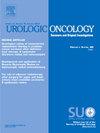开放与机器人辅助根治性膀胱切除术的两年资源利用:来自optum的去识别clinformatics®数据集市数据库的结果。
IF 2.4
3区 医学
Q3 ONCOLOGY
Urologic Oncology-seminars and Original Investigations
Pub Date : 2025-04-02
DOI:10.1016/j.urolonc.2025.03.002
引用次数: 0
摘要
目的:尽管越来越多的人采用机器人根治性膀胱切除术(RRC),但其成本效益仍然存在问题。因此,我们旨在比较RRC和开放式根治性膀胱切除术(ORC)的2年资源利用率(RU)。方法:从Optum的去识别Clinformatics®数据集市数据库中查询2014年至2017年期间诊断为膀胱癌并接受根治性膀胱切除术的患者。连续入组≥2年的患者采用开放和机器人方法分层。RU从每次后续住院/门诊就诊的事件住院费用和2年内的总标准化费用进行评估。采用多元广义线性回归(MGLR)来确定手术入路对后续RU的影响。结果:共发现2373例患者。在连续入组≥2年的患者中(N = 1353),798例(59%)接受了RRC, 555例(41%)接受了ORC。RRC的RU低于ORC(65,188.02美元对80,375.90美元,P < 0.0001),住院费用较低(29,142美元对42,329美元,P < 0.001)。与ORC相比,RRC显示出更短的中位住院时间(5天vs 7天,P < 0.0001),并且与更低的急性肾衰竭(3% vs. 5%, P = 0.007)、肠梗阻(2% vs. 5%, P = 0.005)和输血(≤2% vs. 6%, P < 0.001)相关。MGLR表明,机器人方法独立降低了总成本(β 0.84, CI 0.77-0.93, P < 0.001)。结论:与ORC相比,RRC可降低2年RU和住院费用。机器人技术与较低的总成本独立相关。虽然粒度成本度量细节有限,但RRC降低的RU代表了一种降低术后发病率的新评估。本文章由计算机程序翻译,如有差异,请以英文原文为准。
Two-year resource utilization of open vs. robot-assisted radical cystectomy: Results from optum's de-identified clinformatics® data mart database
Purpose
Despite increasing adoption of robotic radical cystectomy (RRC), its cost-effectiveness remains in question. Therefore, we aimed to compare 2-year resource utilization (RU) between RRC and open radical cystectomy (ORC).
Methods
Queried from Optum's de-identified Clinformatics® Data Mart Database, patients diagnosed with bladder cancer who underwent radical cystectomy were identified between 2014 and 2017. Patients with ≥2 years of continuous enrollment were stratified by open and robotic approach. RU was evaluated from incident hospitalization costs and total standardized costs over 2 years for each subsequent inpatient/outpatient visit. Multivariate generalized linear regression (MGLR) was used to determine the impact of surgical approach on subsequent RU.
Results
About 2,373 patients were identified. Of patients with continuous enrollment for ≥2 years (N = 1353), 798 (59%) underwent RRC and 555 (41%) underwent ORC. RRC was associated with lower RU than ORC, ($65,188.02 vs. $80,375.90, P < 0.0001) and lower inpatient costs for incident hospitalization ($29,142 vs. $42,329, P < 0.001). RRC, versus ORC, demonstrated shorter median length of hospital stay (5 vs. 7 days, P < 0.0001), and was associated with lower rates of acute kidney failure (3% vs. 5%, P = 0.007), ileus (2% vs. 5%, P = 0.005) and blood transfusions (≤ 2% vs. 6%, P < 0.001). MGLR demonstrated that robotic approach independently reduced total cost (β 0.84, CI 0.77–0.93, P < 0.001).
Conclusions
RRC is associated with reduced 2-year RU and incident hospitalization costs compared to ORC. Robotic technique was independently associated with lower total costs. While granular cost metric details are limited, the reduced RU with RRC represents a novel assessment of reduced postoperative morbidity.
求助全文
通过发布文献求助,成功后即可免费获取论文全文。
去求助
来源期刊
CiteScore
4.80
自引率
3.70%
发文量
297
审稿时长
7.6 weeks
期刊介绍:
Urologic Oncology: Seminars and Original Investigations is the official journal of the Society of Urologic Oncology. The journal publishes practical, timely, and relevant clinical and basic science research articles which address any aspect of urologic oncology. Each issue comprises original research, news and topics, survey articles providing short commentaries on other important articles in the urologic oncology literature, and reviews including an in-depth Seminar examining a specific clinical dilemma. The journal periodically publishes supplement issues devoted to areas of current interest to the urologic oncology community. Articles published are of interest to researchers and the clinicians involved in the practice of urologic oncology including urologists, oncologists, and radiologists.

 求助内容:
求助内容: 应助结果提醒方式:
应助结果提醒方式:


